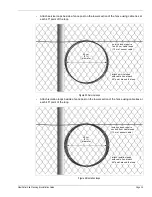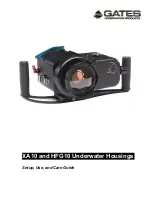
FiberPatrol Site Planning & Installation Guide
Page 51
4
Maintenance
Recommended maintenance
The FiberPatrol sensor requires minimal maintenance to ensure proper operation. However,
setting up and following a maintenance schedule based on your site-specific requirements can
ensure proper detection performance, prevent nuisance alarms and extend the operational lifetime
of the system. The frequency at which the maintenance should be scheduled depends on your
security requirements and on the installation environment. This section includes the recommended
maintenance activities along with suggested intervals.
1. Perform a visual inspection of the installation (quarterly). Check for the following:
•
fence condition - ensure the fence is in good condition and that there are no loose panels,
loose fittings or metal bits that can move with the wind and cause nuisance alarms (a
shake test in which you grip the fence fabric in the middle of a panel and shake it back and
forth with an increasing amount of force can help identify any loose pieces)
•
gates - ensure that all gate hardware is tight and secure and cannot move in the wind
•
there are no washouts or depressions under the fence
•
vegetation beside and above the fence is cut back and cannot make contact with the
fence (the frequency at which vegetation must be cut back depends on the local growing
conditions)
•
the sensor cable is fastened firmly against the fence fabric and the cable ties are holding
the cable securely in place
•
there is no loose sensor cable
•
service loops and isolation loops are securely attached to the fence fabric
•
splice enclosures are properly mounted and secured according to the installation
instructions
2. Physically test the system (once per week at randomly selected locations; once per year at all
locations). High security sites should increase the frequency of testing (daily at randomly
selected locations; twice per year at all locations).
Note
FiberPatrol strongly recommends that the fence be kept clear of
accumulating snow and ice. Both snow and ice have a dampening effect
on the transmission of vibrations and will lead to a reduced probability of
detection. Significant snow accumulation can also provide a bridging aid
for defeating the sensor.










































